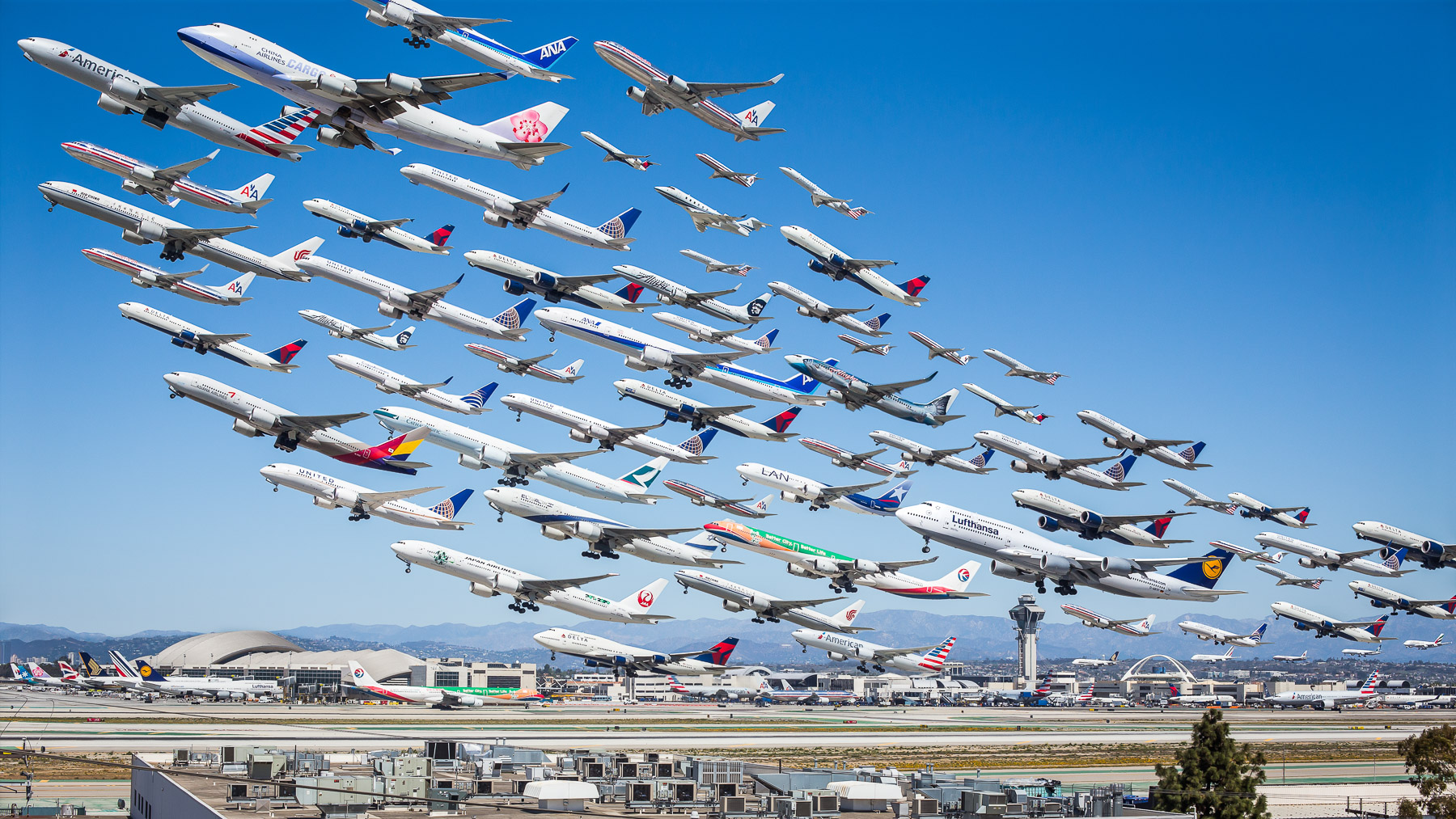This week we’re checking out Mike Kelley’s Airportraits, or those photos of dozens of planes taking off and landing in the same frame; relaxing to a soothing stream of jellyfish; and talking about why so many restaurants have gone bankrupt.
Title illustration by Nick Criscuolo. Additional photo by Nicholas Eckhart.
Welcome to Lifehacker’s Thinking Cap, a series where we round up interesting, informative and thought-provoking podcasts, interviews, articles and other media that will teach you something new, inspire you and hopefully cap off your week nicely.
Airportraits

You’ve probably seen Mike Kelley’s photos before. He stitches together shots of aircraft either taking off from airports or coming in for a landing and creates those gorgeous “flocks” of aircraft all flying through the same sky, landing or leaving the ground together. I talked to him briefly about his background and experiences taking these shots, especially the LAX shot that you’ve likely seen before:
I’m actually an architectural photographer by trade, and in that line of work I’m doing a lot of compositing: Blending lighting, time of day and people as I photograph buildings. Believe it or not, architectural photography requires a lot of Photoshop in many instances, so I’ve been working with photo composites for years now in order to give my photos an interesting look and feel.
So that brings us to the original image from LAX, conceived in 2014. I’ve always been fascinated by aviation and one day while out at LAX plane spotting, decided that I wanted to try capturing multiple takeoffs and putting them together into a single image to show their flight paths and the sheer volume of traffic departing LAX. The crazy thing is that the first image was originally supposed to just be a proof-of-concept to see if the idea had any legs. I put it on the internet as kind of a, “hey, check this little thing out that I did, it’s kind of cool,” and it just went crazy viral.
The inspiration behind the entire set of images was somewhat simple given the success of the original. I didn’t want to be a one-hit wonder, and I knew the idea had potential, so it was sort of something that had to be done. There are a ton of amazing airports, airlines and aeroplanes out there that I wanted to photograph, so the plan was set in motion to try and capture as many as possible. Since I’m obsessed with aeroplanes, travel and seeing new places, it was also a great excuse to get me out of my comfort zone a little bit. At the time I started the project, I had been photographing architecture for about five years straight and a break was in order, so it was also a nice change of pace!
I mostly chose airports based on their setting or how iconic they are on a global scale. Heathrow is obviously one of the most well-known, for better or worse, airports in the world, set in the middle of what is probably the most famous city on earth. Haneda is the busiest airport in the world, and you can see the iconic Mt Fuji on a perfect day – I wanted to tie these amazing locations together with their air traffic in a way that hadn’t been seen before.
Kelley is a professional photographer, so we’re not about to just include a ton of examples of his work here – you’ll have to head over to his site – and you absolutely should. Best of all, if you like what you see, you can always buy a print, so you could always adorn your walls with a little aviation. While you’re at it, give Mike a follow on Twitter and on Instagram. [via Mike Kelley, thanks Kottke!]
Why Are So Many US Restaurant Chains Filing for Bankruptcy?

From Ruby Tuesday to Bob Evans, a ton of US restaurant chains that used to be considered the bedrocks of the suburban American dining industry are drying up, shuttering branches and cutting back operations. What happened? Our friends at Consumerist took a look at the whole scenario:
Over-saturation, new fast-casual entrants, and customers’ desire to just eat at home have something to do with it, the Wall Street Journal reports, suggesting that the already announced closures are likely just the beginning of what could be a major restaurant industry shakeup.
Having a variety of food options at your disposal is great for hungry consumers, but you eventually get to the point where there aren’t enough people eating out to support all of those restaurants.
So in many ways, it’s a matter of oversaturation; competition from better, other restaurants (specifically fast casual places like Chipotle and Panera are named in the story); and then, on top of it all, Americans just aren’t eating out quite as much as they used to. Restaurant visits overall are down, and even some of those mentioned fast casual places haven’t been able to escape cutbacks – Cosi recently announced 29 stores would close and filed for bankruptcy.
It’s possible that restaurant saturation in many communities has just peaked in relation to the customer base available for them. Simple economics, but it does mean that something has to give, and well, now we see what. [via Consumerist]
The Weirdest Items Confiscated by the Transportation Security Administration
The TSA confiscates some strange, strange stuff, and if you need proof of that, look no further than their Instagram account. Plus, CNet put together this simple slideshow (ugh, we know) of strange, wacky and unusual items that the TSA has collected from checked and carry on bags across the US. Some notable examples? A bag of eels, the loaded gun buried in a mass of modelling clay buried inside of an old computer case shown above (which was in a checked bag, which is insane because they could have just packed the gun in the checked bag, unloaded and it would have been fine), an actual cannonball, an actual cannon, a bottle of seahorses and batarangs. So many batarangs. Check out the whole slideshow, seriously. [via Cnet]
Millions of Smart Devices Are Being Hijacked to Help Criminals
Ah, the “internet of things“, the new frontier of connected devices, appliances and other products in your home and on your body that all have internet access and all communicate with one another. Back in the 2000s we called this “convergence”, when manufacturers of home appliances and such desperately wanted to put tech in your living room and kitchen – and now, somehow, it’s just finally started to catch on. There’s only one catch – smart devices usually aren’t very smart when it comes to securing themselves and their data.
That means, as Consumerist notes, millions of them have already been compromised and are being used by criminals as parts of DDoS attacks, botnets and other web-based attacks. We’ve mentioned this (and how to protect your home network and devices) before, but it’s an even more prevalent problem now, and it’s only getting worse, as a recent threat report from Akamai (PDF) notes. From Consumerist:
Millions of the connected devices being sold and brought online every day are poorly secured at best. We’ve covered it happening with everything from baby monitors to firearms in recent months.
Huge swaths of devices ship with well-publicised default passwords or no passwords at all on them, making it trivial for someone with bad intentions to access them remotely. That covers the entire gamut of appliances and gadgets, from coffeemakers to routers to thermostats to televisions, and anything in between.
And those, Akamai says, are exactly the problem. Anyone with the mind and technical ability to do so can use all those “smart” but-not-smart gadgets as a giant computing network to do, well, whatever nasty things they want.
So basically, smart appliances are the new routers, in that you need to make sure you set them up properly when you get them home, don’t give them internet access unless they need it, change their default passwords and, when you do give them internet access, it’s through a router or another device you can control and monitor. [via Consumerist]
A Relaxing, Soothing Livestream… of Jellyfish
Jellyfish are probably some of the most interesting animals (in my opinion, anyway.) Many of them are so incredibly dangerous, but biologically they force us to reconsider some of the criteria we have for what qualifies as “life”. That said, you don’t have to consider such heavy questions to enjoy this beautiful livestream of jellies at the Monterey Bay Aquarium. Sometimes they’re in frame, sometimes it’s just their super-long tendrils, but at all times it’s peaceful and oddly soothing. Enjoy. [via Monterey Bay Aquarium (YouTube)]
That’s all for this week. If you have thought-provoking stories, interesting podcasts or eye-opening videos, share them in the comments below!

Comments